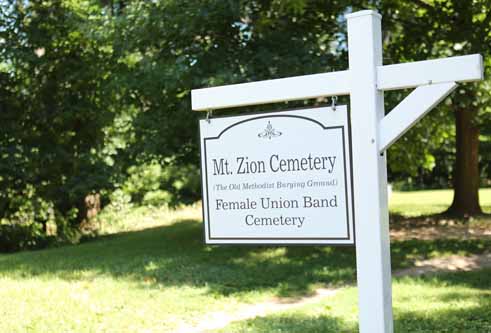Mount Zion Cemetery Wins Funding

By Grace BirdCurrent Correspondent
Amid the meticulous effort to preserve the historic Georgetown neighborhood, one of the nation’s oldest black cemeteries has been abandoned there for decades, disappearing amongst rubble and overgrown weeds.
But Mount Zion Cemetery, located at 26th Street and Mill Road NW, may at last see its fortunes reversed this year. Ward 2 D.C. Council member Jack Evans successfully pushed for the city’s budget to set aside $200,000 for cemetery repairs.
The cemetery’s land was originally purchased by the Dumbarton United Methodist Church in 1808, functioning as an interracial cemetery. In the mid-18th century, white burials shifted to Oak Hill Cemetery next door, and the oldest black congregation in the country, the Mount Zion United Methodist Church, purchased the land and continued burials of African-Americans there until 1950. Mount Zion Church is still in possession of the land today.
The cemetery, said to be a stop on the Underground Railroad, was decommissioned by the city in 1953 after falling short of health standards. In the 1960s, developers eyed the lucrative land — including the adjacent Female Union Band Cemetery — but were ultimately fended off by activists.
Vincent DeForest, president of the Afro-American Bicentennial Corp., successfully led efforts to add the cemetery to the National List of Historic Places in the mid-1970s. Today, DeForest cautions that any cemetery restoration efforts must be sustainable.
“It’s been hard because each year grass grows — it’s not something that you can do one time and then go on to something else,” he said in an interview. In 2012, the cemetery was included on the DC Preservation League’s “most endangered” list, due to its state of disrepair.
DeForest, who is in his 80s now, has devoted his life to lobbying for equality in America’s historic sites — because to eliminate history, he said, is to create a false present. “We understand the world on the basis of our history,” DeForest said. “It’s more than a project — you’re talking about a legacy.”
Longtime activist Neville Waters, a descendent of some of the first black Georgetown residents, has joined DeForest at the forefront of Mount Zion’s restoration efforts since the 1970s. Waters sees the site’s neglect as the combined result of racism and discomfort. “The memory is so painful and evil you don’t want to think about it,” Waters told The Current. “The lack of awareness is a defense mechanism.”
A Mount Zion cemetery foundation that includes members of the clergy intends to apply for the cemetery restoration funding when it becomes available at the start of fiscal year 2018, according to Waters.
Council member Evans told The Current that the application is only a formality and that he is confident the funding for Mount Zion will be approved. “The way that it’s written, it shouldn’t be difficult,” Evans said of the budget measure.
Fifth-generation Georgetowner Monica Roache became involved in efforts to restore the cemetery when she was elected to the area’s advisory neighborhood commission three years ago.
“Oftentimes, people just aren’t aware of the history and the story,” Roache said in an interview. “African-Americans were not just slaves in Georgetown. They were business owners, they were doctors, and they were lawyers — they made significant contributions to the community.”
While Georgetown’s black community comprises less than 5 percent of the population today, during the 19th and early 20th centuries it hovered between 30 and 40 percent. Despite rampant discrimination, black residents flourished in supportive enclaves, building businesses, churches and schools, and finding avenues to engage in politics.
Exact spending plans for the restoration funding haven’t yet been decided, Roache said. However, she is optimistic that cleanup efforts will shed light on Georgetown’s African-American history for residents and out-of-towners alike. “I’d like this to be a destination when tourists come to D.C,” Roache said.
In advance of the city’s restoration funds, a volunteer cleanup day tackled the cemetery in April. Participants included 80 Georgetown Visitation Preparatory School students and their fathers.
“It was a great day,” Visitation’s head of school Daniel Kerns told The Current. “We hope to make it an annual tradition.”
This article appears in the June 28 issue of The Georgetown Current newspaper.
